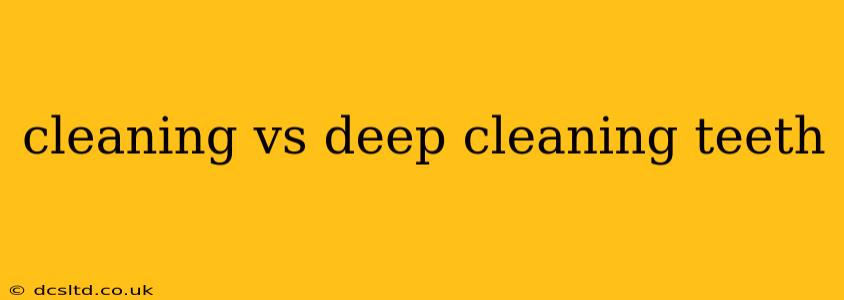Maintaining optimal oral hygiene is crucial for overall health. However, the terms "cleaning" and "deep cleaning" often cause confusion. This comprehensive guide clarifies the distinctions between these two essential dental procedures, helping you understand when each is necessary and how they contribute to a healthy smile.
What is a Regular Teeth Cleaning?
A regular teeth cleaning, also known as a prophylaxis, is a preventative procedure performed by a dental hygienist. This routine cleaning aims to remove plaque and tartar buildup that accumulates on the teeth's surfaces and along the gumline. The process typically involves:
- Professional Cleaning: The hygienist uses specialized tools, including a scaler and polishing brush, to meticulously remove plaque and tartar. Plaque is a sticky film of bacteria that contributes to cavities and gum disease. Tartar, or calculus, is hardened plaque that requires professional removal.
- Polishing: After removing plaque and tartar, the teeth are polished to create a smooth surface, making it more difficult for plaque to adhere.
- Fluoride Treatment: Often, a fluoride treatment is applied to strengthen tooth enamel and help prevent cavities.
- Oral Hygiene Instruction: Your hygienist will review proper brushing and flossing techniques, providing personalized advice to improve your at-home oral care.
Regular cleanings are typically recommended every six months, although this can vary depending on individual needs and risk factors.
What is a Deep Cleaning (Scaling and Root Planing)?
A deep cleaning, also known as scaling and root planing, is a more extensive procedure necessary for individuals with periodontal disease (gum disease). This procedure addresses the deeper pockets of infection that develop between the teeth and gums. It involves:
- Scaling: The hygienist or periodontist uses specialized instruments to remove plaque and tartar from both above and below the gumline, reaching deep into the periodontal pockets.
- Root Planing: This step smooths the tooth roots to eliminate bacteria and encourage the gums to reattach to the teeth.
Deep cleanings are typically performed in two separate appointments, one for the upper teeth and one for the lower teeth. This allows for thorough cleaning and minimizes discomfort. Local anesthesia may be used to ensure a comfortable experience.
How Often Should I Get a Deep Cleaning?
The frequency of deep cleanings depends on the severity of gum disease and individual response to treatment. While regular cleanings prevent the need for deep cleanings in healthy individuals, those with periodontal disease may require deep cleanings every three to four months or more frequently. Your dentist will determine the appropriate schedule based on your specific situation.
What are the signs that I might need a deep cleaning?
This is a crucial question that many individuals ask. Several signs can indicate a potential need for a deep cleaning:
- Bleeding Gums: Persistent bleeding while brushing or flossing is a strong indicator of gum inflammation.
- Red or Swollen Gums: Inflamed gums are often a sign of gingivitis, the early stage of gum disease.
- Receding Gums: Gums that pull away from the teeth expose the tooth roots, increasing the risk of infection and tooth loss.
- Persistent Bad Breath: While bad breath can have multiple causes, persistent bad breath may indicate underlying periodontal issues.
- Loose Teeth: If your teeth feel loose, it’s essential to seek professional dental care immediately.
What is the difference between a regular cleaning and a deep cleaning?
The primary difference lies in the depth of cleaning and the treatment target. A regular cleaning focuses on removing surface plaque and tartar, while a deep cleaning addresses deeper periodontal pockets and bacterial infection beneath the gumline. Regular cleanings are preventative, while deep cleanings are therapeutic.
How much does a deep cleaning cost?
The cost of a deep cleaning varies depending on the location, the extent of the periodontal disease, and the dentist's fees. It's generally more expensive than a regular cleaning because it's a more extensive procedure. It’s recommended to contact your dental insurance provider to understand your coverage.
Will my insurance cover a deep cleaning?
Most dental insurance plans cover at least a portion of the cost of a deep cleaning, but coverage can vary significantly depending on your specific policy. Check your plan's details for specific coverage information.
By understanding the differences between regular cleanings and deep cleanings, you can proactively maintain your oral health and prevent serious dental problems. Remember to schedule regular checkups and cleanings with your dentist to maintain a healthy and beautiful smile.
